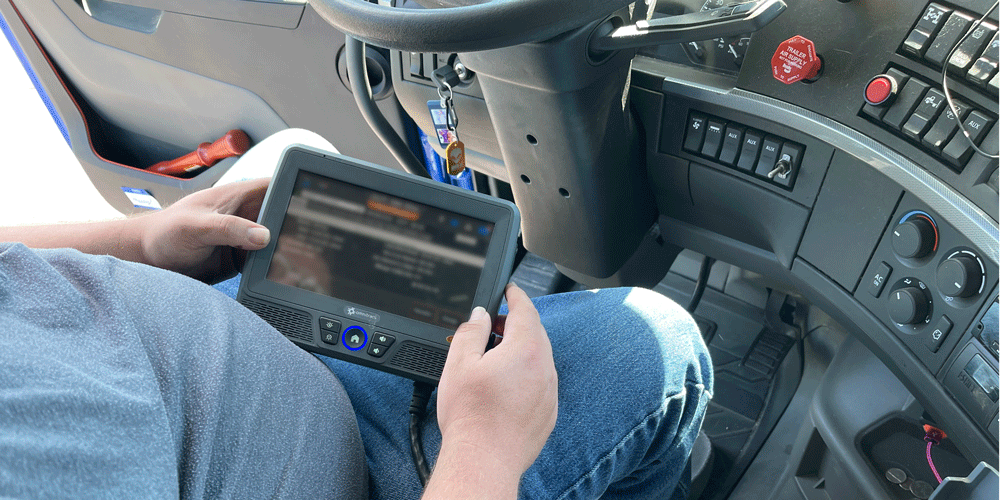Kelli has been in the trucking industry since 2003. She got her start working in compliance for a trucking carrier that specialized in government freight. She has been the compliance manager with ATS since 2017.
Electronic logging devices (ELDs or e-logs) for truckers play a critical role in keeping drivers compliant, efficient, and safe on the road. Understanding how ELDs work, how to manage your logs, and how to stay within your Hours of Service (HOS) limits helps you avoid violations and stay focused on driving.
At Anderson Trucking Service (ATS), we provide drivers with securement training, route planning, permitting, and safety technology. That includes ELD training, so drivers can feel confident using this tech to log and manage their hours behind the wheel.
In this article, we’ll explain the rules that govern electronic logging devices for truckers, how e-logs work, and tips for using them.
Key Takeaways for Drivers
-
The ELD Mandate requires commercial drivers to use certified ELDs to track HOS.
-
ELDs automatically record driving time, location, and engine data.
-
Understanding how to operate and maintain your ELD helps prevent costly violations.
-
ATS provides training, trip-planning support, and the latest safety technology to help drivers stay compliant.
Understanding the ELD Mandate
The Federal Motor Carrier Safety Administration (FMCSA) introduced the ELD Mandate to ensure commercial drivers accurately record their HOS.
HOS rules exist to help prevent driver fatigue; fatigued drivers are at a greater risk of accidents. Research cited by the National Transportation Safety Board (NTSB) suggests driver fatigue is a factor in 30-40 percent of all heavy truck accidents.
To that end, ELD Mandate requires carriers to install approved ELDs that automatically collect data such as engine hours, location, and miles driven. This ensures compliance, transparency, and greater road safety.
Before the mandate, drivers relied on paper logs or automatic on-board recording devices (AOBRDs). Paper logs varied widely between drivers and were prone to human error.
By contrast, certified ELDs standardize how data is collected, stored, and reported. They're also much more efficient: ELDs plug directly into the vehicle’s onboard diagnostics port and pull data from the engine. Once the data is collected, the data is transmitted via Bluetooth or cellular service to the mobile application.
Who Is Exempt from the ELD Mandate?
Not all commercial vehicles fall under the mandate. Exemptions to the ELD Mandate include:
- Trucks with model years 1999 or older
- Short-haul drivers using timecards
- Driveaway-towaway drivers
- Agricultural or farm vehicles
Because these older vehicles typically lack an engine control module (ECM), they can’t connect to ELD hardware.
Electronic Logging Devices for Truckers: How It Works
Modern ELDs connect directly to the vehicle’s engine to track movement and activity. When you start your day, you can select from four statuses: on-duty, driving, sleeper berth, or off-duty. Once your truck reaches 5 miles per hour (mph), the device automatically switches to drive mode and records driving time until the vehicle stops.
This automation helps eliminate guesswork and ensures your HOS are tracked precisely. At the end of the day, drivers review and certify their logs within 24 hours. While you can edit certain details like on-duty time, drive time cannot be modified because it’s directly tied to engine data.
ELD Rules: What Truckers Need to Know
For truckers, ELDs are relatively hands-off — certainly less labor-intensive than paper and pencil logging! But there are a few things drivers need to know about their responsibilities regarding ELD use, maintenance, and rules.
- Drivers must have the following in their trucks at all times to be compliant with the mandate:
- Paper log book
- Instruction sheet on ELD malfunctions
- Instruction sheet on ELD use and how to transfer data to an officer
- ELD user manual
- If the ELD unit breaks, it has to be repaired within eight days, according to FMCSA regulations.
- While you’re waiting for a broken ELD to get fixed, you can only be on paper logs for a maximum of eight days in a 30-day rolling period.
For example, if you used paper logs for an eight-day period of March 15–22, you can’t use paper logs again at the start of April just because it’s a new month. You wouldn’t be able to use paper logs again until 30 days have passed after the first day you started using them (March 15).
Repairing your unit within eight days and not being on paper logs for more than eight days are listed separately in the regulation book, which means you can get a violation for them separately.
Likewise, if you are found without the paper log book, user manual, and instruction sheets in your truck, you can get a violation point, which will go against your carrier’s Compliance, Safety and Accountability (CSA score).
Tips for Using E-logs
When used correctly, electronic logging devices save time, simplify compliance, and reduce the risk of violations. They also make trip planning easier, helping you maximize your hours and protect your CSA score. Here are some of our best tips for using e-logs effectively:
- Always switch yourself to on-duty at the start of your shift. Need help remembering to do so? A simple sticky note with a written reminder in a prominent place can do wonders.
- Update load details at every pickup and drop-off. Make it part of your routine.
- Plan your route carefully to ensure adequate rest stops within your HOS limits. Lean on the expertise of your carrier, driver manager, and/or dispatcher for assistance with tricky routes/loads.
- Report and repair ELD malfunctions within eight days, per FMCSA regulations. Waiting can only lead to compliance violations, safety concerns, and downtime.
Become a Trip Planning Pro with ATS
When it comes down to it, the ELD Mandate is just another way to help drivers maximize their HOS and stay well-rested, so they can be more alert and safe on the job. It's a tool in your toolbelt (albeit a mandatory one), which can be used in tandem with other strategies and tactics like creating thorough trip plans daily.
When you trip plan, you make it less likely that a surprise will pop up on the road; you have a plan for everything so that you’re more likely to succeed and to stay within your hours.
We’ve put together an article that explains how you can become a pro at trip planning, which will not only help you stay within your HOS, but will also help you boost your income.





